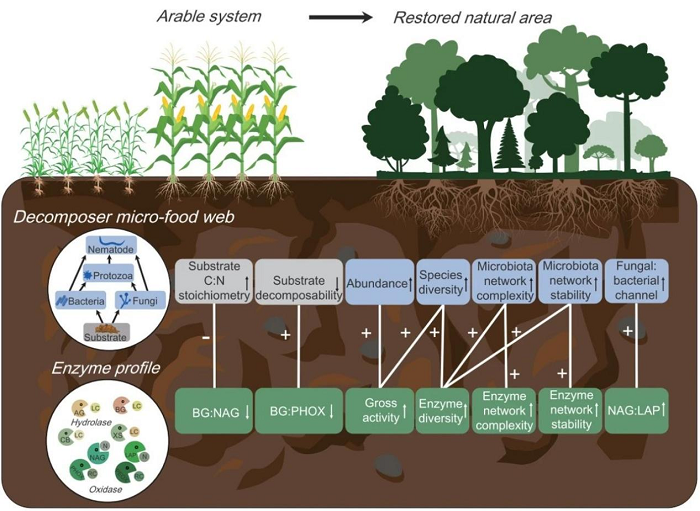Recently, the Agricultural Clean Watershed Innovation Team of the Institute of Environment and Sustainable Development in Agriculture, CAAS developed an enzyme group analysis method to indicate the structural characteristics of the soil decomposition micro-food web. The related research findings have been published in iMeta.
The soil micro-food web plays a crucial role in regulating biogeochemical cycles and maintaining ecosystem functions. Highly diverse microbial extracellular enzymes mediate the energy flow from substrate resources to multi-trophic level microbiota within the soil decomposer micro‐food web.

This study firstly established a “soil enzyme profile analysis” approach to develop a series of enzyme profile indices; those indices were hypothesized to reflect micro‐food web features. The shifts in enzyme profile indices were systematically evaluated in relation to the micro‐food web features in the restoration of an abandoned cropland to a natural area. It was found that enzymatic C:N stoichiometry and decomposability index were significantly associated with substrate availability. Furthermore, the higher Shannon diversity index in the exoenzyme profile, especially for the C‐degrading hydrolase, corresponded to a greater microbiota community diversity. The increased complexity and stability of the exoenzyme network reflected similar changes with the micro‐food web networks. In addition, the gross activity of the enzyme profile as a parameter for soil multifunctionality, effectively predicted the substrate content, microbiota community size, diversity, and network complexity. Ultimately, the proposed enzymic channel index was closely associated with the traditional decomposition channel indices derived from microorganisms and nematodes. These results showed that soil enzyme profile analysis reflected very well the decomposer food web features. The study has important implications for projecting future climate change or anthropogenic disturbance impacts on soil decomposer micro‐ food web features by using soil enzyme profile analysis.
This study was supported by the National Natural Science Foundation of China and the Agricultural Science and Technology Innovation Program of the Chinese Academy of Agricultural Sciences.
Linkage DOI: https://doi.org/10.1002/imt2.161

